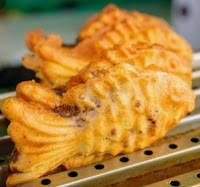Introduction
One of the best ways to experience a country's culture is through its food, and in Korea, street food plays a significant role in daily life. From bustling night markets to small food stalls on street corners, Korea offers a variety of delicious and affordable snacks that have captivated both locals and tourists alike. Whether you’re strolling through Myeongdong, visiting Gwangjang Market, or exploring Insadong, you’ll find an incredible range of flavours and textures that make Korean street food truly special. In this blog post, we’ll introduce some of the most popular street foods in Korea, their history, and why you must try them when visiting.
1. Tteokbokki (Spicy Rice Cakes)
Tteokbokki is arguably the most iconic Korean street food. Made from chewy rice cakes cooked in a spicy-sweet gochujang (red chilli paste) sauce, this dish is a staple of Korean food stalls. The vibrant red sauce gives it a bold, flavourful kick, making it a favourite comfort food, especially during the colder months.
Variations of Tteokbokki
Gungjung Tteokbokki – A royal court version made without gochujang, featuring a soy sauce-based flavour with beef and vegetables.
Cheese Tteokbokki – Topped with melted cheese for a creamy, rich taste.
Rosé Tteokbokki – A fusion variety made with a creamy, tomato-based sauce.
Tteokbokki is often enjoyed with soondae (Korean blood sausage) and twigim (Korean tempura) to balance its spiciness.
2. Hotteok (Sweet Korean Pancake)
Hotteok is a beloved winter street food, featuring a crispy, golden-brown dough filled with a sweet mixture of brown sugar, cinnamon, and crushed nuts. When cooked, the sugar caramelises inside, creating a deliciously gooey centre.
Variations of Hotteok
Seed Hotteok – A specialty from Busan, filled with sunflower, pumpkin, and sesame seeds along with the classic sugar filling.
Savoury Hotteok – Some versions include fillings like vegetables or cheese for a unique twist.
Hotteok is best enjoyed fresh off the griddle, especially on a chilly day with a cup of hot tea.
3. Eomuk (Fish Cake Skewers)
Eomuk, also known as odeng, is a Korean fish cake often served on skewers in warm broth. This dish originated from Japan but has been adapted into a Korean street food favourite.
Why You Should Try Eomuk
Perfect Winter Snack – The hot broth is comforting and warms you up instantly.
Customisable Flavours – Some vendors offer spicy, curry-flavoured, or cheese-filled variations.
A cup of the rich, savoury broth is often provided for free, making it a great choice for those looking for something light yet satisfying.
4. Kimbap (Korean Seaweed Rice Rolls)
Kimbap is sometimes referred to as "Korean sushi," but it has its own distinct flavours. Made with seasoned rice, various fillings like egg, fish cake, pickled radish, and vegetables, all wrapped in seaweed, kimbap is a convenient and healthy snack.
Popular Types of Kimbap
Chamchi (Tuna) Kimbap – Filled with tuna and mayonnaise.
Samgak (Triangle) Kimbap – A triangle-shaped version, commonly found in convenience stores.
Cheese Kimbap – A fusion twist that includes melted cheese.
Kimbap is often enjoyed as a light meal or picnic food, making it a versatile street food option.
5. Dak-kkochi (Grilled Chicken Skewers)
Dak-kkochi is a popular street food consisting of grilled chicken skewers coated in a sweet and spicy sauce. The combination of tender, juicy chicken and the smoky char from the grill makes it an irresistible treat.
Why You Should Try It
Bold and Flavourful – The sauce is a perfect blend of spicy, sweet, and savoury.
Easy to Eat – Served on skewers, it’s a convenient snack for exploring the streets.
Some vendors also offer soy garlic-flavoured or cheese-topped variations for different taste preferences.
6. Bungeoppang (Fish-Shaped Pastry)
Bungeoppang is a classic Korean street snack shaped like a fish and filled with sweet red bean paste. The crispy outer shell and soft, warm filling make it a favourite among both locals and tourists.
Variations of Bungeoppang
Custard-Filled Bungeoppang – A sweeter, creamier alternative to the red bean version.
Chocolate Bungeoppang – A more modern take, popular among younger crowds.
This snack is particularly popular during winter, when vendors sell them fresh and piping hot.
7. Soondae (Korean Blood Sausage)
Soondae is a traditional Korean sausage made with pig’s intestines stuffed with a mix of glass noodles, rice, and sometimes blood. Despite its unique ingredients, it’s a well-loved delicacy among street food lovers.
Best Ways to Enjoy Sundae
With Tteokbokki Sauce – Many people dip sundae in the spicy tteokbokki sauce.
With Salt and Ganjang (Soy Sauce) – A simple and classic way to enhance the flavour.
For those new to soondae, the chewy texture might be surprising, but it’s definitely worth a try!
8. Twigim (Korean Tempura)
Twigim refers to a variety of deep-fried snacks similar to Japanese tempura. It includes ingredients like sweet potatoes, seaweed rolls, shrimp, and even boiled eggs coated in batter and fried to crispy perfection.
Popular Types of Twigim
Kimari (Seaweed Roll Twigim) – Glass noodles wrapped in seaweed, battered, and deep-fried.
Yachae Twigim (Vegetable Tempura) – Carrots, sweet potatoes, and peppers fried for a crispy snack.
Twigim is often paired with tteokbokki, as the crunchy texture contrasts nicely with the chewy rice cakes and spicy sauce.
Conclusion
Korean street food is an essential part of the country's vibrant food culture. Whether you're indulging in spicy tteokbokki, savouring the sweetness of hotteok, or warming up with a cup of eomuk broth, there's something for everyone. The affordability, convenience, and variety of flavours make street food an exciting way to explore Korea’s culinary heritage. Next time you visit Korea, don’t miss the chance to take a delicious street food tour and experience the local flavours firsthand!







